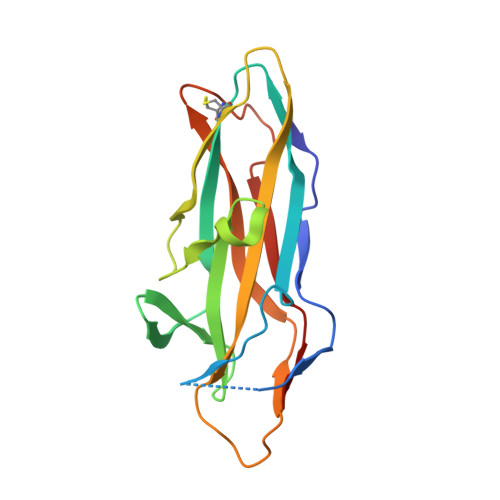Structural Sampling of Glycan Interaction Profiles Reveals Mucosal Receptors for Fimbrial Adhesins of Enterotoxigenic Escherichia coli.
Lonardi, E., Moonens, K., Buts, L., de Boer, A.R., Olsson, J.D., Weiss, M.S., Fabre, E., Guerardel, Y., Deelder, A.M., Oscarson, S., Wuhrer, M., Bouckaert, J.(2013) Biology (Basel) 2: 894-917
- PubMed: 24833052
- DOI: https://doi.org/10.3390/biology2030894
- Primary Citation of Related Structures:
3F64, 3F6J, 3FFO, 4BWO, 4K0O - PubMed Abstract:
Fimbriae are long, proteinaceous adhesion organelles expressed on the bacterial envelope, evolutionarily adapted by Escherichia coli strains for the colonization of epithelial linings. Using glycan arrays of the Consortium for Functional Glycomics (CFG), the lectin domains were screened of the fimbrial adhesins F17G and FedF from enterotoxigenic E. coli (ETEC) and of the FimH adhesin from uropathogenic E. coli. This has led to the discovery of a more specific receptor for F17G, GlcNAcb1,3Gal. No significant differences emerged from the glycan binding profiles of the F17G lectin domains from five different E. coli strains. However, strain-dependent amino acid variations, predominantly towards the positively charged arginine, were indicated by sulfate binding in FedF and F17G crystal structures. For FedF, no significant binders could be observed on the CFG glycan array. Hence, a shotgun array was generated from microvilli scrapings of the distal jejunum of a 3-week old piglet about to be weaned. On this array, the blood group A type 1 hexasaccharide emerged as a receptor for the FedF lectin domain and remarkably also for F18-fimbriated E. coli. F17G was found to selectively recognize glycan species with a terminal GlcNAc, typifying intestinal mucins. In conclusion, F17G and FedF recognize long glycan sequences that could only be identified using the shotgun approach. Interestingly, ETEC strains display a large capacity to adapt their fimbrial adhesins to ecological niches via charge-driven interactions, congruent with binding to thick mucosal surfaces displaying an acidic gradient along the intestinal tract.
Organizational Affiliation:
Center for Proteomics and Metabolomics, Leiden University Medical Center, P.O. Box 9600, RC Leiden 2300, The Netherlands. e.lonardi@lumc.nl.















